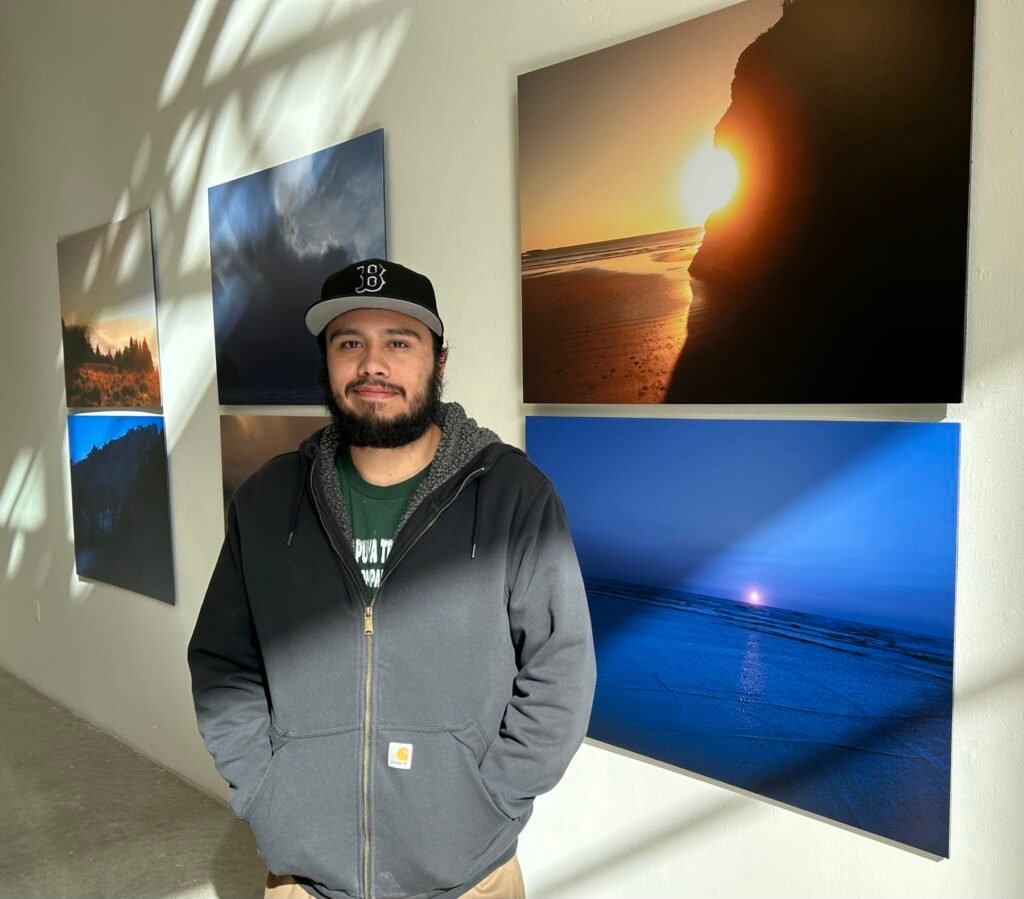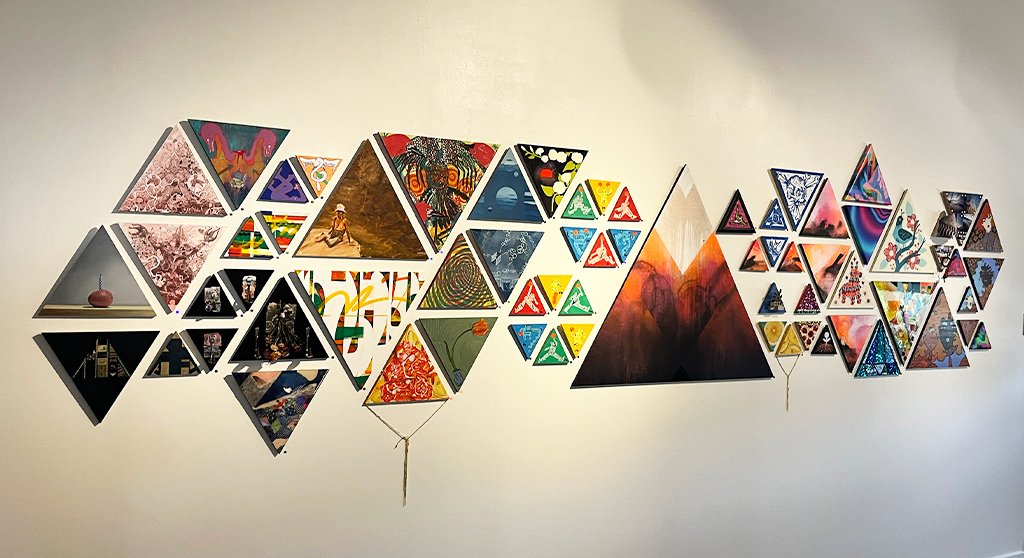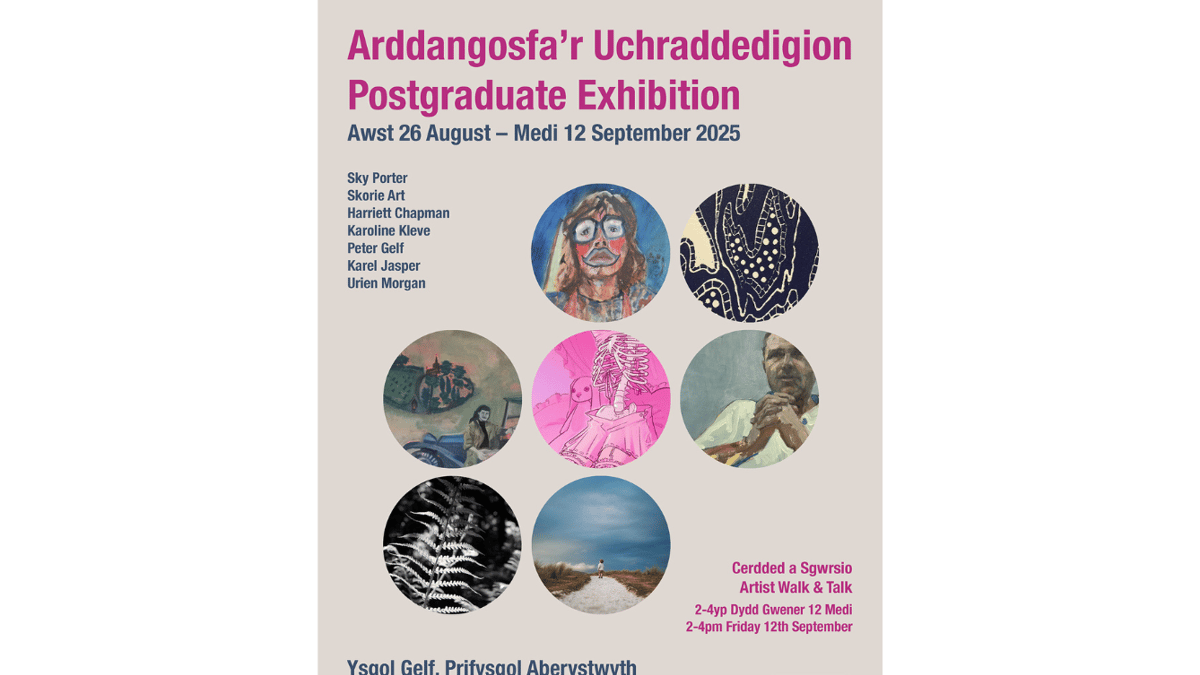
If you stand on a beach or a bluff or a cliff looking at the ocean along the Oregon Coast and no ships or surfers are in view and no piece of modernity falls within your field of vision, you’re basically looking back in time. This is exactly what someone standing where you are thousands of years ago would, presumably, also have seen.
I thought of that recently while looking at Leland Butler’s gorgeous pictures hanging in the Linfield University Art Gallery, many of which he shot at the coast.
Timelessness, of course, is what photography does. Some of the moments captured in the two dozen images that compose Connected to the Land appear as they might have to Butler’s ancestors many millennia ago: He is a Grand Ronde tribal member, and is also Siletz and York.
But beyond the geographic and atmospheric information represented in these digital photographs is mood — deliberately so. The 29-year-old Butler speaks openly about struggling with depression and anxiety. About 10 years ago, he discovered that packing a camera to the beach or into the woods on the reservation just west of Yamhill County served as a kind of therapy.
Half the images are of beaches and/or the ocean in all kinds of weather, seasons, and times of day. There’s one obligatory sunset shot, the one everyone takes on cellphones. But the sun appears in only a few of these pictures; the rest are drenched in varieties of overcast, some where fog and light make it impossible to distinguish among land, sea, and sky. One, which prominently features a railroad bridge, he shot on the Umatilla Reservation in Eastern Oregon near a popular swimming hole.
One I kept coming back to (none of the images is titled) shows a beach where jagged rocks dominate the left side, running up against a bluff where what are likely stairs appear more like a ladder. As in another beach scene, the sky is very dark, except a streak of light on the horizon on the right. It’s a look that has prompted many beach walkers to ask, Is it going to finally clear off, am I about to get drenched? These and several of the other “dark” beach scenes seem rich in ambiguity and possibility.
“I like to go out in any type of weather,” Butler told me as we walked around the gallery one morning last week. “This day,” he added, pointing to the image described above, “it was supposed to be a clear day, and then it started raining. This was a moment when it was not raining.” In another melancholy beach shot, he captured the moment during snowfall. Yet another was shot in the midst of trees very late in the day, when the sunlight slants in almost horizontally.

“Some of these pictures, I can just picture the day,” he said, pointing to another beach scene littered with driftwood and logs. “Like up here, that wasn’t the greatest day. I just needed to get out and explore.” For capturing scenes that align with his own interiority, a “nice day” is not always desirable.
“Every day is the potential for a good day to take photos,” he said. “The sun doesn’t need to be out, it doesn’t need to be dry. Put a zip-lock over your camera and you’re good.”
The 24 images appear in two rows and are deliberately paired vertically. Generally, cool blues sit below or are perched above warmer scenes with browns and yellows, then the order is reversed. A theme that emerges is the mysterious and yet somehow orderly mix of light and dark — both within single images and in their placement with each other.
Butler describes his aesthetic in the show notes:
Over the course of making photos, I’ve become attached to the duality of light and shadow and the beauty it creates in an image. With that same idea, there is an internal exploration that takes place throughout life and similarly, one can find the beauty in the duality of our own internal light and shadow through expression and exploration (internally and externally).
The spiritual journeys we embark on to find life’s answers about self often bring us back to nature, and that’s what connects us to the land.
Butler makes the point that in Indigenous cultures, artistic creation isn’t regarded as something separate from life itself. With his father singing and mother fashioning the clothing, he’s participated in pow-wows. “You don’t really see that as ‘art,’” he said. “It’s creativity, it’s a way of life.”

Perhaps because of that — of not thinking of himself as an artist — it took a second party to make Connected to the Land Happen.
Lyle Cairdeas is the exhibits coordinator at the Chachalu Museum and Cultural Center in Grand Ronde, and for the second year in a row he’s working with Linfield to display Indigenous art during the annual Camus Festival, which has in recent years become part of the McMinnville-based university’s cultural offerings in May. Butler showed him his images late in 2023 and got a few into a show at Chachalu.
“I was impressed with his command of photography, the refinement of his compositions, and the variety of subjects he gathered over many years,” Cairdeas said. He was surprised that Butler had never publicly shown his work other than on social media and thought an exhibit heading into the Camus Festival would be a perfect opportunity.
The festival honors the cultural significance of camas flowers and other plants and landscapes important to Indigenous peoples of the Pacific Northwest. The gallery show ends May 3, so the pictures will go from there to the Linfield Library for this year’s festival on May 10. Grand Ronde staff will be available to give tours of the camas patches in nearby Cozine Creek, as well as explain traditional natural materials and objects.
“This is such a strong exhibition,” Cairdeas said. “I’m so excited to see where Leland goes on his artistic journey.” For his part, Butler is humbled that the journey took him and his photographs into a spacious, sun-drenched gallery in McMinnville.
“I’m new to all this, I’m just kind of going with the flow,” he said. “I’m just now seeing myself as an artist, whereas before it was just the way I live, just the different, quirky things I do. Then I get offered to do something like this, and I’m like, should I be in a space like this?”
Yes, he really should.








